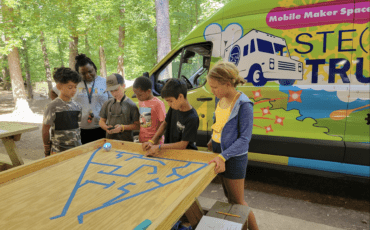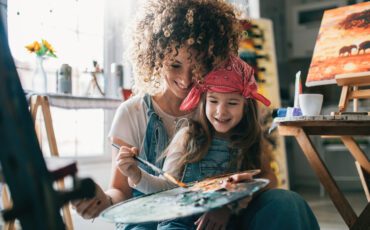Future Stars of the Arts
Atlanta is home to some truly talented kids and teens. From playing instruments in Carnegie Hall to performing on Broadway, you might be amazed by some of the accomplishments of our city’s young arts students. Here’s a look into how they got started, why they love what they do, and advice for aspiring performers and artists.
Ovie, 17, and Arjun, 13, Nirgudkar
Pace Academy
 This brother and sister pair make a dynamic duo that have played at Carnegie Hall multiple times. Ovie plays the piano and has since she was 4. Arjun plays the cello and loves the adrenaline rush it brings. Ovie has also graced international stages – Royal Albert Hall in London and the Sheremetev Palace in St. Petersburg; Arjun is currently the principal cellist for the Georgia Youth Symphony Orchestra Philharmonic Division.
This brother and sister pair make a dynamic duo that have played at Carnegie Hall multiple times. Ovie plays the piano and has since she was 4. Arjun plays the cello and loves the adrenaline rush it brings. Ovie has also graced international stages – Royal Albert Hall in London and the Sheremetev Palace in St. Petersburg; Arjun is currently the principal cellist for the Georgia Youth Symphony Orchestra Philharmonic Division.
- Her favorite thing about performing: It’s a mode of universal communication. Every audience can understand what she chooses to convey, and that is very special. She also loves the thrill of putting on a beautiful dress, doing up her hair and walking on stage with confidence.
- What he wants you to know about him: Watch out! He’s just getting started.
“We would both like to say that none of our success would be possible without our parents and our teachers. They push us – first, to have good values and character, and second, to always outwork the competition.”
Cameron Flotta, 13
The Mount Vernon School
 Cameron is a middle schooler with a future in sound design. At the Georgia Junior Thespian Conference, his work received a Superior score and was recognized at the closing ceremony. He also presented his sound design at the International Thespian Festival this summer. He was one of only a few middle schoolers to receive his medal on stage at the closing ceremony in front of an audience of more than 3,500 festival attendees.
Cameron is a middle schooler with a future in sound design. At the Georgia Junior Thespian Conference, his work received a Superior score and was recognized at the closing ceremony. He also presented his sound design at the International Thespian Festival this summer. He was one of only a few middle schoolers to receive his medal on stage at the closing ceremony in front of an audience of more than 3,500 festival attendees.
- How he got started: He started sound design at the beginning of 7th grade when he was 12. At the end of his 6th grade year, he learned about sound design and tried it out on a small show they did, but it really started in 7th grade when he did the entire process by himself.
- His favorite thing about sound design: Finding the sounds is a lot of fun because you can discover random funny sounds while trying to find the perfect sound for that cue.
“If you want to try out sound design, make sure you always go through and read the script two or more times. This helps a lot to make sure you don’t make any mistakes or leave out some important moments in your show.”
Margaret Black, 17
Marietta High School
 Margaret was exposed to all things music related at a very young age, because both of her parents are musicians. She saw how her dad could convey emotions without words and a deeper meaning to music. She’s been playing the piano and singing ever since.
Margaret was exposed to all things music related at a very young age, because both of her parents are musicians. She saw how her dad could convey emotions without words and a deeper meaning to music. She’s been playing the piano and singing ever since.
- Her favorite thing about performing: For Margaret, the most gratifying part about performing are the deep bonds you make with your fellow musicians and with your audience. Some of her strongest and most resilient friendships have blossomed through chorus and theater.
- Her most recent role: Playing the Woman in Chair as a part of Marietta High School Theatre department’s production of “The Drowsy Chaperone.” This is one of the biggest roles she has ever received.
“To anyone who wants to perform – just do it. Don’t listen when other people say that it isn’t cool to be in the arts, because that could not be farther from the truth. It doesn’t matter what other people think about it. You can change the world through performing.”
Marco Schittone, 15
The Galloway School
 Marco got his big break on Broadway in “Tuck Everlasting” several years ago. Since then, he’s worked on a variety of local plays and been cast in several onscreen performances, including “Just Beyond” on Disney+, “Doom Patrol” on DC Universe and “Sleepy Hollow” on Fox, as well as his most recent project “I Want You Back” on Amazon Prime Video.
Marco got his big break on Broadway in “Tuck Everlasting” several years ago. Since then, he’s worked on a variety of local plays and been cast in several onscreen performances, including “Just Beyond” on Disney+, “Doom Patrol” on DC Universe and “Sleepy Hollow” on Fox, as well as his most recent project “I Want You Back” on Amazon Prime Video.
- How he got started: At 5 years old, his acting journey began at the Alliance Theatre during summer camp when he played the role of the tortoise in “The Tortoise and the Hare.”
- His favorite thing about performing: The people he has met and worked with, such as Broadway stars Andrew Keegan-Bolger and Michael Park, plus celebrities like Clint Eastwood, Bradley Cooper and Gina Rodriguez. To him, it feels like one big family when working with a big crew.
“Having the experience of being on Broadway will forever be one of the best experiences of my life. Walking out on stage every night for about 4 months and seeing around 1,000 people looking at me and living my dream is something that I will never forget and miss incredibly.”
Owen Axelberd, 16
Atlanta Music High School
 Composing music may not sound like a teenager’s hobby, but that’s exactly how it started for Owen. Now, his compositions are being played at the prestigious Interlochen Arts Camp. This past summer, his pieces included a brass quintet, a mixed ensemble piece for cello, viola, clarinet and flute, and even a piece for double bass and mandolin.
Composing music may not sound like a teenager’s hobby, but that’s exactly how it started for Owen. Now, his compositions are being played at the prestigious Interlochen Arts Camp. This past summer, his pieces included a brass quintet, a mixed ensemble piece for cello, viola, clarinet and flute, and even a piece for double bass and mandolin.
- How he got started: He started watching many videos on YouTube on music theory. These inspired him to try composing, so he bought a copy of Sibelius and started experimenting!
- His advice for other kids: Find a way to make it interesting. Learning an instrument or composition takes consistent practice each day. If you can find a way to make practicing exciting, then practicing each day should be a breeze. Even a little practice is better than none at all, so have fun!
“I firmly believe that anyone at any age can be a great musician no matter how late they start, so long as they have the passion and dedication. I hope if you are on the fence about learning an instrument that you will not make age the deciding factor!”
Arts in Education: Where Academics and Creativity Meet
The arts are inherently connected to more traditional academic subjects like math, science and reading. Here’s a more in-depth look at these intersections.
- Music and Math: Learning music boosts math skills. Foundationally, music is math. When students learn to read sheet music when playing an instrument or singing in a chorus, they have to understand the time signatures, beats per minute and formulaic progressions.
- Visual Arts and Science: The methods of creating a visual arts project and conducting a scientific experiment are similar. They each have their own specific steps – ask a question, investigate, observe, analyze, conclude – that mirror one another and result in a finished product. Also, an artist must understand visual perspective, color and light – all of which are scientific concepts.
- Theater and Reading: The obvious connection is that you have to read a script in order to perform a play. Aside from this, performing requires reading comprehension skills. If a student does not understand the story or that is happening to her character, it can be very difficult to progress as an actress.
10 Outstanding Outcomes of Arts Education
The arts have an amazing impact on learners, no matter what medium. From practical abilities to strengthening connections to academic subjects, the arts give students life skills that will come in handy long after the classroom.
- Leadership: Being creative means you feel comfortable thinking outside of the box and sharing your ideas with others, which translates into becoming a future leader.
- Resilience: The creative process teaches students that failing or making mistakes is a natural part of learning and of life.
- Responsibility: Managing project deadlines, memorizing lines, learning the architecture of the time and maintaining a portfolio – these smaller tasks will create students who can effectively handle all levels of responsibility.
- Collaboration: Being part of a cast, band, chorus or art show forces students to work together, and communicate their different perspectives and ideas.
- Empathy: The arts are the perfect outlet for exploring someone else’s motivations, emotions and perspectives.
- Respect: The arts tell stories from around the world and in different formats, which creates a foundation of understanding of people and mediums students may not have familiarity with.
- Appreciation: Students who know what it takes to create art or perform in front of others will have a greater affinity for the arts as they get older.
- Engagement: When students are learning in a hands-on manner, they are more likely to be interested in the subject matter.
- Confidence: Learning to speak in front of others and share their unique perspectives gives students the confidence in who they are as artists and as people.
- Community: Students get to be around others who share their passion and a feeling of mutual respect.
-Tali Benjamin





